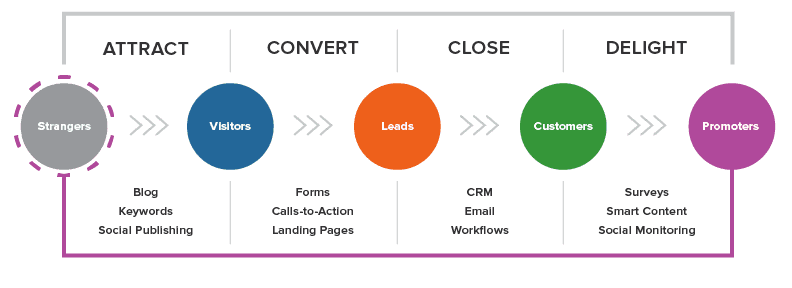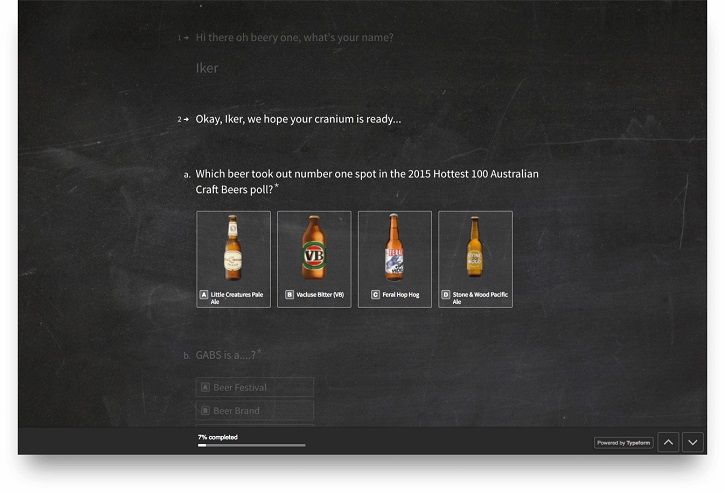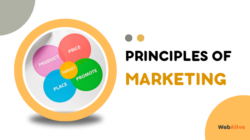
Inbound Marketing 101: A Beginner’s Guide
From marketing the masses to luring leads in and converting them to customers: the way marketing works has turned around, quite literally. Inbound marketing is much more than just a buzzword: it’s an essential strategy for businesses that want to grow.
Although everything inbound begins and ends with your website, it only represents 10% of your entire inbound marketing strategy. Here’s the other 90%.
What does inbound marketing mean anyway?
Remember the days of not getting weirdly specific ads on your phone? When you only saw commercials for cars, vacuum cleaners, and banking services – even though you were still living with your parents, couldn’t drive and wouldn’t clean? Sure, there was the occasional sneaker that caught your eye, but that was it. Now that, that was outbound marketing.
The way this worked, is that it targeted as many people as possible, hoping that in that crowd, some potential customers would be convinced by the commercial. It’s also known as interruption marketing, and it has lost its spark.
With the growing amount of content we consume every day, this became less and less effective. So things changed. Luckily.
The idea of inbound marketing is that you create reasons for the customer to come to you. It revolves around a brand’s ability to be found by potential customers, following a trace of content that is specifically targeted at potential leads.
The four stages of inbound marketing
Inbound marketing takes the customer’s buying process into account, so you can adapt your strategy to it. For this, we distinguish four different stages.
- Hello, stranger! But really. In the first phase, you attract people who don’t know your brand yet with content and by being visible in search engines to get them to visit your website.
- In the second stage, you convert these visitors into leads. For this, you need information from them – and they need value from you. Think about exchanging email addresses for white papers or ebooks.
- Time to seal the deal: by closing the sale, you turn leads into paying customers. But don’t pop the champagne just yet.
- To make the most of all those previous efforts, you will want to delight your customers. This will turn them into promoters for your brand and keep them coming back.

The four stages of inbound marketing. Image Source: Neil Patel
So what’s the role of your website?
It’s where the magic happens. From the first to the last step, your website plays an important role: you want (potential) customers to come back there at every stage. Ultimately, it’s a meeting point and hub where you and your client will find each other.
But what will drive them back there every time, until they decide to ‘add to cart’ or ‘book appointment’? It’s more than a beautiful, smoothly functioning website. Without the following elements, your inbound marketing is incomplete.
Essential elements of a successful inbound marketing strategy
Want to get started with inbound marketing? If you’re still on the fence: inbound marketing generates three times more leads per dollar than traditional methods. Now, we’ve got that out of the way, let’s continue.
Inbound marketing needs a well thought out infrastructure with different key aspects that work together. Apart from your website, here are the other facets to take care of.
Buyer persona: do you know who you’re talking to?
Just like your website, this will be the glue that holds your strategy together. Who will be buying what you sell? Who will consume the content you create?
Do you feel understood by the brands you encounter when looking for a certain product or service? Chances are you don’t: nearly 80% of customers say they feel companies don’t understand them.
Creating your buyer persona means you get to really know your ideal client. Not just generic demographics, but also their behavior, challenges, and goals. Then, you can figure out how you can help them with that, and through which channels.

Content marketing: it’s not about you
When you have your buyer persona figured out – and only then – you can start creating and distributing content. Keep in mind that high-quality content isn’t promoting your company. It is providing valuable information that solves the problems of your persona.
Blog posts, podcasts, vlogs, infographics: whatever you make, focus on creating something your visitors will find valuable. This will build trust and brand authority and gives them a reason to return to your website – or even share your content.
Social media marketing
Just cool content on your website won’t do the trick, because how will people find you in the first place? Social media is here to help, and a vital part of almost any inbound marketing strategy.
Aim at creating original content that makes you memorable. A great way to do this is to post content your audience can engage with. Stuck in a social media routine of posting links to blog posts or repeating videos and images that nobody seems to interact with?
Instead of posting static content in which your brand is the focus point, consider creating interactive content. Ever considered creating a quiz? It’s highly shareable, and at the same time, it helps you to get to know your audience better.

With a fun quiz, Beer Cartel collects leads and gets to know their customers.
Onsite and offsite content
Your website also plays an important role in your content marketing strategy. But it’s also what you do outside of your website that will lead visitors there. To gain visibility with new audiences, also post on external websites and platforms. This will create referral traffic. It also benefits your SEO. So let’s dive right into that, shall we?
Search Engine Optimization: it’s all about great experiences
From blog posts, it’s a small leap to search engine optimization. Apart from on- and offsite content and link building, there’s more work to be done here. A comprehensive SEO strategy goes beyond keywords.
There’s a whole lot of technical optimization to be done, which mostly revolves around the user’s experience. Make sure your website is optimized for mobile devices, get that site speed pumped up, and don’t forget to actually measure your efforts, to keep improving.
Pay-Per-Click advertisements: be top of mind, and search results
Paid marketing tools aren’t always outbound marketing. Look at PPC marketing, for instance: this is still considered inbound. That’s because it doesn’t interrupt viewers and isn’t random: advertisements only appear when users actively search for something related online.
Even though it’s paid, make sure you continue to focus on providing value. You don’t just want people to see your ad, you want them to click on it. That should lead them to a relevant landing page or piece of content that drives them forward in their customer journey.
Email marketing: great for customer retention
How does email marketing fit in a strategy that focuses on not being interrupting? By collecting high-quality leads that are actually interested in the high-quality content you will send them.
Email marketing and lead generation go hand in hand, and is relevant for not just potential customers, but also existing ones.
You get their email address by luring them in with value. This also means that you create different pieces of content and offers based on which stage of the buyer’s journey you find your subscribers in.
Marketers have found that segmenting your email marketing campaigns can increase their revenue from email with a staggering 760%. Want to take it even a step further? Don’t just segment your audience, but show them personalized content.
The power of personalization
To be clear: we’re not talking about using their first name in the opening of your emails and calling it a day. You can do better than that! For example, thanks to retargeting tactics, you can show custom landing pages to new or returning visitors.
91% of consumers are more likely to buy from brands that provide personalized offers and recommendations that are relevant to them. Your website again plays an important role here, helping you to give direct product suggestions while your visitors are shopping.
Integration and data-driven decisions
And finally, we would like to give a special shout out to data. All of the above wouldn’t be possible without it. This will be the foundation of all decisions you make. Inbound marketing and integration of all tools you use go hand in hand.
Collecting the right, relevant and real-time data requires a smooth integration of whatever systems you work with. From your website to your social media channels, you will need to keep track of your efforts, leads, customers, and how your content is performing.
Grow your business: switch that sales funnel
Marketing is ever-changing, and the amount of content we consume is growing. Catching our attention is becoming increasingly difficult. It’s evident that inbound marketing is here to stay.
However, it is a quite demanding strategy, requiring a thorough approach in which all aspects have to work together. There’s no great inbound marketing strategy without a website, but you will also need great content writing, SEO specialists, and skilled social media marketers – and the list goes on.
If you’re ready to flip the switch and have your customers find you, instead of you hunting for them, start with getting to know your ideal client. We can help you with creating an awesome website.
You read a lot. We like that
Want to take your online business to the next level? Get the tips and insights that matter.

